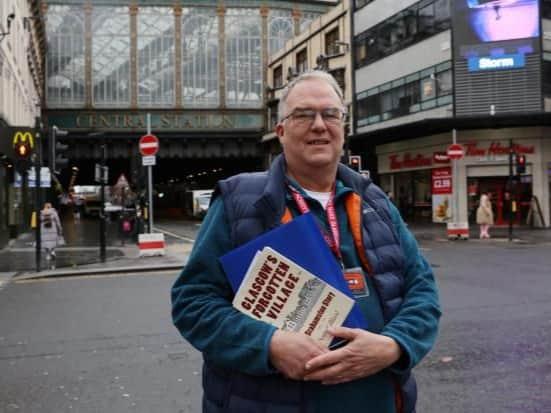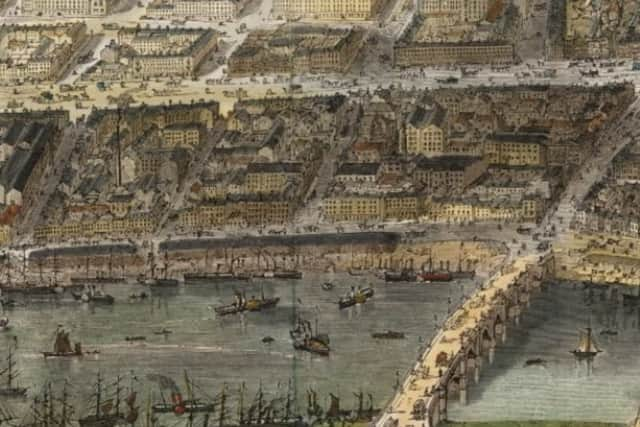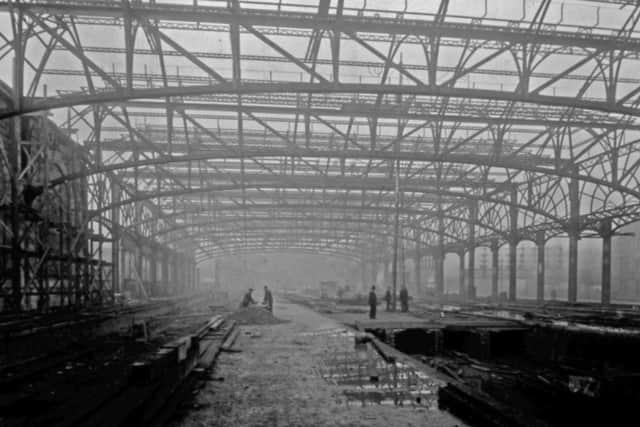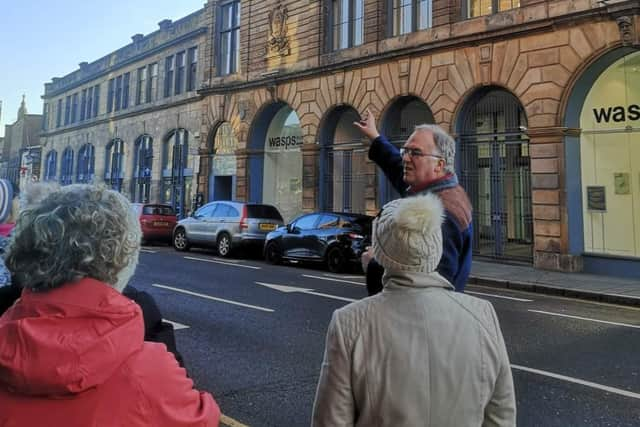Glasgow’s Hidden History: ‘My family were from Grahamston, Glasgow’s forgotten village’
and live on Freeview channel 276
Grahamston, Glasgow’s forgotten village. While the likes of Anderston, Finnieston, and Govanhill were absorbed into modern Glasgow - Grahamston was simply demolished and paved over, sacrificed to create the sprawling footprint for Glasgow Central Station.
It’s hard not to feel drawn to these stories, whether you’re local or from further afield, the concept of forgotten and hidden history is magnetic - but it leaves us with so many questions.
Advertisement
Hide AdAdvertisement
Hide AdWhat was it like to live in Grahamston? Who lived there? Why did it disappear almost entirely?
Sometimes we have to accept that we’ll never get all the answers to these questions - but that’s not the case today, as we got the opportunity to speak to one of the only living people to claim ancestors from the village of Grahamston.
Last month we wrote an article: ‘The forgotten hidden village buried beneath Glasgow Central Station’ - and it wasn’t long thereafter that Kevin Scott got in touch, a Glasgow tour guide claiming to have family links to the village.
Kevin says that around a third of the tour participants he gets are from Glasgow, and are just interested in learning local history. While the rest are tourists, he does get a large contingent of Glaswegian expats looking to reconnect with local history.
Advertisement
Hide AdAdvertisement
Hide AdTake a look below as we picked the local historian’s brain about Grahamston - and the story behind the forgotten village and the people who lived there.
How did you find out your family were from Grahamston?
I thought I was a Borderer all my days, I used to write books on Border history, I ran a clan society for 20 years.
Although I’ve lived the bulk of my life in Glasgow, it was only a few years ago I traced my family tree - and it led right back to 1700 at the bottom of Hope Street, which back then was a part of Grahamston.
I managed to get my hands on birth certificates from the John Cleland building on the corner of Buchanan and Sauchiehall Street. Cleland was responsible for the first census in Britain, Glasgow was the first place to ever hold a census.
Advertisement
Hide AdAdvertisement
Hide AdThe rabbit hole just kept getting deeper and deeper because while I was looking into that, I found that John Cleland’s father was the signatory on my ancestor’s birth certificates, as he was also one of the few people living in Grahamston at the time.
It was by chance, I stumbled into my ancestors birth certificates while researching a building connected to the old village.
For someone as interested in history as I am, finding out I had this personal connection was uncanny, I really had to pinch myself.
Who were your Grahamston ancestors?


After finding out about my connection to Grahamston I looked further into it using resources from Trades House and the Mitchell Library, and found that my ancestor William Scott was actually a deacon at the Institute of Gardeners.
Advertisement
Hide AdAdvertisement
Hide AdThey were market gardeners, one of six market gardens in Grahamston at the time. In their garden they had an orchard, selling principally fruits and vegetables, both to people in Glasgow and to the first tobacco lords sailing across the Atlantic to the Americas.
Like a true politician, he would sell his fruit and veg and such at Glasgow Cross during the day, before disappearing down into Grahamston at the other end of Argyle Street to avoid paying taxes.
How many people lived in Grahamston?
Back then the village only had a population of 110 people. My family was a mother and father with nine children, making my family a tenth of the population at the time.
The population of Glasgow itself was only around 12,000 at the time, I always tell people that the whole of the city could fit into one night of Kevin Bridges at the Hydro.
Advertisement
Hide AdAdvertisement
Hide AdAt its height Grahamston had a population of around 2000 - but in the end this dwindled to around 160 - with the encroaching trade on the Clyde and then the industrial-era relying on more and more warehouse space.
Where was the village of Grahamston?


Grahamston could be found underneath Glasgow Central Station, although it was not as large as the station is today, and incorporated Union Street and Hope Street too. Although Hope Street wasn’t as long as it is today, it wasn’t even connected to Argyle Street until 1830.
Mitchell St marked one side of this village in the 1700’s, whilst Waterloo St was its westernmost point.
What was the main industry of Grahamston?
Grahamston had a lot going on for such a small village, it had one of the first Sugar Houses around Glasgow, as well as the old Alston theatre on Alston Street which ran into Central Station.
Advertisement
Hide AdAdvertisement
Hide AdMostly Glasgow was renowned for the quality of its fruit - would you believe? Apples and Oranges, unbelievable.
Weaving was the main bit at Anderston and then that industry gradually crept towards the city. In Glasgow they were mostly up on Weaver Street, Shuttle Street, and various other streets in ‘Strathclyde Uni Land’.
So weaving was the initial trade and then fishing from St Enoch’s Burn, Molendinar Burn, and the Kelvin as well as the Clyde.
That was all until the Clyde was scooped out and we could trade with America - which of course gave rise to the tobacco lords.
Advertisement
Hide AdAdvertisement
Hide AdAs industry grew in Glasgow people started arriving, from the highland clearances, the Ayrshire & Irish potato famine - which brought a lot of weaving folk over to the city as well who had better techniques for weaving which saw Anderston grow.
Following the American Civil War putting an end to the slave trade, the main industry of Glasgow was once again weaving.
However, once the Forth and Clyde Canal was extended and the Monklands Canal began to bring coal from Lanarkshire ready to fire the factories and begin industrialisation, that spelt the beginning of the end for Grahamston.
How did the village on Grahamston disappear?


Grahamston gave itself to Glasgow, well I say gave itself, Glasgow Central swallowed it up as they increased from 3 to 9 to 17 platforms.
Advertisement
Hide AdAdvertisement
Hide AdWhen Grahamston was closed, it was through compulsory purchase orders from the City of Glasgow. My ancestor put up a bit of a fight about getting ousted from his market garden - and himself and another gentleman went to court, in which my family settled for a sum of £2.14 for about 2 or 3 acres on Hope Street.
Now I do a walk on Buchanan Street where each building costs around £30 million each - so this is why I’m walking the streets, there’s no legacy money for me.
The town of Grahamston refused to sell Hope Street to Glasgow, which explains why a few streets in the city centre run squinty as opposed to straight in a grid-iron pattern like the rest of the city.
There’s a kind of strange dichotomy of interest, because obviously my family were ousted from the area. But at the same time, I’ve still got that connection to some of the earliest inhabitants of Glasgow I suppose.
Is there any trace left of Grahamston in Glasgow today?


Advertisement
Hide AdAdvertisement
Hide AdA lot of romantic stuff was written about Grahamston talking about cobbled streets and abandoned wooden houses and shopfronts.
In a sort of Harry Potter fashion, the main street of Grahamston, Alston Street, runs directly underneath platforms 3 and 4, or platform 3 and a half as I like to call it. Alston Street didn’t even run as far as Gordon Street from Argyle Street, only running to around halfway up the platform.
While there might be a few pieces of the old cobbled underneath the platforms, you’ll not find much else - although the Grant Arms building and the Rennie Mackintosh hotel are both surviving buildings from Grahamston.
Another fun fact about Grahamston is that the Sir John Moore used to a bakery in Grahamston, coincidentally, also called Wetherspoons.
Advertisement
Hide AdAdvertisement
Hide AdKevin runs a free tour around Grahamston - all strictly above ground, though Glasgow Central Tours can take you a tour of the underground sections of the Victorian train station - in which he sets the scene of Grahamston as it was hundreds of years ago.
Scott runs the tours out of a personal interest in history and sharing it with others - though he does offer participants on free tours the option to donate to the RNLI afterwards. To find out more about Kevin’s tours revealing Glasgow’s hidden history, check out his website Walking Glasgow.
To find out more about the hidden history of Grahamston, you can check out our article on the subject here, or for a more in-depth look, you can read ‘Glasgow’s Forgotten Village: The Grahamston Story’ by Norrie Gilliland, written on the village back in 2002.
Kevin Scott is also set to give a talk on Grahamston at eight libraries across Glasgow this winter season, so if you’re curious about the old forgotten town and have any pressing questions for Kevin, these are the events to go to.
Comment Guidelines
National World encourages reader discussion on our stories. User feedback, insights and back-and-forth exchanges add a rich layer of context to reporting. Please review our Community Guidelines before commenting.
